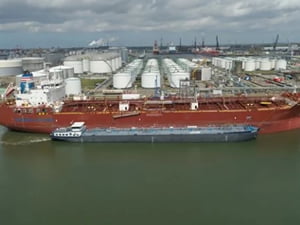Clarksons Research has announced that the renewal of the global maritime fleet has taken a significant step forward in 2023, accounting for 45% of all newbuilding orders placed last year by gross tonnage and capable of operating on alternative fuels.
Steve Gordon, Global Head of Clarksons Research, said: “2023 was a hugely important year on the shipping industry’s path to decarbonisation, with new regulation coming into force and the adoption of the net zero commitment at the IMO. “And while it remains only at the beginning of a vital and unprecedented fleet renewal investment programme, a start has been made with 49% of existing order tonnage now filled with alternative fuel,” he said.
Clarksons’ data shows that the largest share of alternative fuel orders in 2023 will again be LNG dual-fuel, but this has increased to 125 methanol dual-fuel ship orders in 2023.
In 2022, a record 55% of all newbuilding orders by tonnage (GT) were for alternative fuel capacity. In this context, 31% of newbuilding tonnage ordered in 2021 was for ships with alternative fuel capacity. This rate was 27% in 2020 and 8% in 2016.
Additionally, new orders have been received for 55 vehicles containing LPG as fuel and now 4 containing ammonia.
The orders include 218 LNG capacity ships of 18.9 million GT (approximately 25% of the total order), 130 methanol capacity ships of 10.3 million GT (13%) and 44 LPG capacity ships, while 121 units of battery- It will be equipped with hybrid propulsion.
Reflecting future “optionality”, there are 579 ships in the fleet and newbuilds with LNG “ready” status, 322 with Ammonia “ready” status and 272 with Methanol “ready” status.
6% of the fleet at sea and 48.8% of the order book by tonnage were able to use alternative fuel or propulsion.
37.4% of the total orders are LNG (916 units), 8.3% are methanol (203 units), 1.7% are LPG (84 units) and approximately 3.3% are hydrogen (8), It is set to use other alternative fuels (379 units), including ethane (43), biofuels (10), and battery/hybrid propulsion (310).
There are currently 444 LNG-ready ships in the fleet and 135 ships on the order book, while there are 249 ammonia-ready, 247 methanol-ready and 14 hydrogen-ready ships on order.
While 83% of container ship newbuilding capacity ordered this year (rising to 94%, including orders with “ready” status) and 79% of car carriers (98%, including “ready” orders) are ordered with alternative fuel capacity, bulk cargo This rate is much lower for ships and tankers.
“Today, 6% of global fleet capacity has alternative fuel capacity (up from 2.3% in 2017), and we predict this will increase to around a quarter of all fleet capacity by the end of the decade,” Gordon said.
Data from Clarksons shows there are other significant developments too, with eco-ships now accounting for 32% of global tonnage on the water (up to 50% on VLCC and Capesize) and the use of innovative Energy Saving Technologies (EST) continuing to grow is showing.
More than 7,295 ships, accounting for 29.5% of the fleet tonnage, have been fitted with energy-saving technologies. This includes propeller ducts, rudder bulbs, Flettner rotors, wind kites, air lubrication systems and others. These include 47 wind-driven ships.
On the other hand, green port infrastructure continues to expand. There are currently 188 active LNG bunkering ports (and 82 planned facilities), while more than 2,743 ships in the fleet are equipped or ready to be equipped with shore power connections.(Offshore Energy)
The opinions expressed herein are the author’s and not necessarily those of News2Sea.
#Order #rate #alternative #fuel #ships #percent
